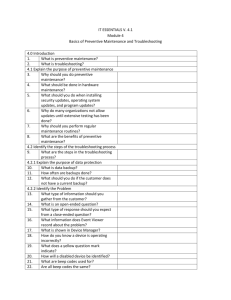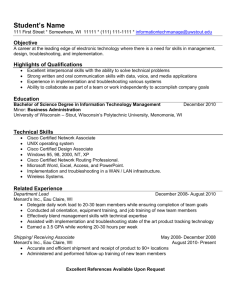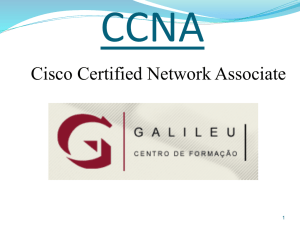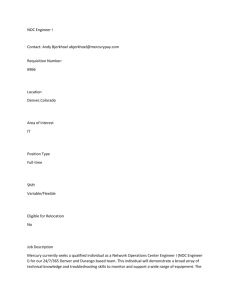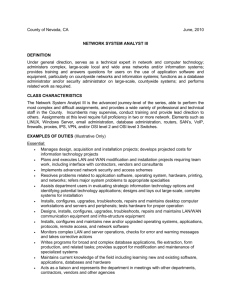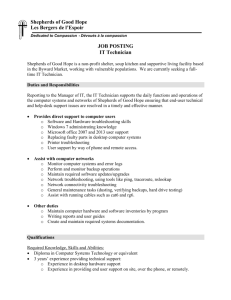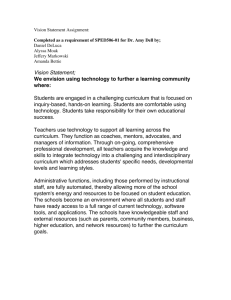Networking Troubleshooting
advertisement
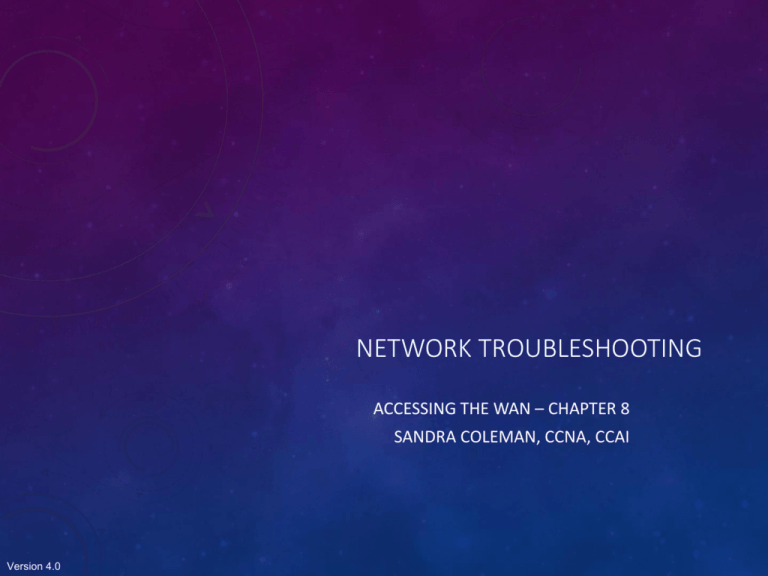
NETWORK TROUBLESHOOTING ACCESSING THE WAN – CHAPTER 8 SANDRA COLEMAN, CCNA, CCAI Version 4.0 OBJECTIVES • Establish a network baseline • Describe troubleshooting methodologies and troubleshooting tools • Describe the common issues that occur during WAN implementation • Troubleshoot enterprise network implementation issues ESTABLISH A NETWORK BASELINE • When establishing a baseline, consider how a network has been designed and what the expected performance for this network should be under normal operating conditions. DOCUMENTING YOUR NETWORK Network topology diagram – should include symbols for all devices and how they are connected. DOCUMENTING YOUR NETWORK End system documentation - hardware and software used in end-system devices such as servers, network management consoles, and desktop workstations. An incorrectly configured end system can have a negative impact on the overall performance of a network. ESTABLISH A NETWORK BASELINE stages of the network documentation process DOCUMENTING YOUR NETWORK • You don’t always have immediate access to every device. Some devices you only have remote access to. • So, how do you discover information about them? • Use these commands: •Ping and/or telnet •Show ip int brief •Show ip route •Show cdp neighbor detail (this will get you IP addresses.. From layer 1 to layer 3… YEAH!) DOCUMENTING YOUR NETWORK • Once you know everything, record the information about what you discovered in the ENTIRE network into the appropriate place… even the remote locations • Transfer that information from the network config tables to the topology diagram. • I had to so something similar to this on my CCNA exam. I was given access to only 1 switch in an entire topology and had to find out IP and MAC addresses of almost every other device. These are the commands I used! ESTABLISH A NETWORK BASELINE • Measuring the initial performance and availability of critical network devices and links allows a network administrator to determine the difference between abnormal behavior and proper network performance as the network grows or traffic patterns change. STEP 1. DETERMINE WHAT TYPES OF DATA TO COLLECT • CPU utilization, and interface utilization is a good place to start. STEP 2: IDENTIFY DEVICES AND PORTS OF INTEREST Network device ports that connect to other network devices, servers, key users, anything else considered critical to operations. STEP 3. DETERMINE THE BASELINE DURATION This period should be at least seven days to capture any daily or weekly trends. Weekly trends are just as important as daily or hourly trends. PERFORMANCE A combination of manual data collection and simple network protocol inspectors would do great. Use these commands on mission critical devices. TROUBLESHOOTING METHODOLOGIES AND TROUBLESHOOTING TOOLS • troubleshooting is a process that takes the greatest percentage their time. Using efficient troubleshooting techniques shortens overall troubleshooting time when working in a production environment. DESCRIBE TROUBLESHOOTING METHODOLOGIES AND TROUBLESHOOTING TOOLS layered models, such as the OSI reference model or TCP/IP model, are used for troubleshooting. Know how these layered models correspond to one another! DESCRIBE TROUBLESHOOTING METHODOLOGIES AND TROUBLESHOOTING TOOLS BOTTOM-UP • you start with the physical components of the network and move up through the layers of the OSI model until the cause of the problem is identified. Most problems are physical ones, so this works well. TOP-DOWN •Start with the end-user applications and move down through the layers of the OSI model until the cause of the problem has been identified. •The disadvantage with the top-down approach is it requires checking every network application until the possible cause of the problem is found. Each conclusion and possibility must be documented. and the challenge is to determine which application to start examining first. DIVIDE AND CONQUER When you apply the divide-and-conquer approach toward troubleshooting a networking problem, you select a layer and test in both directions from the starting layer. DESCRIBE TROUBLESHOOTING METHODOLOGIES AND TROUBLESHOOTING TOOLS • If the problem is outside the boundary of your control, for example, lost Internet connectivity outside of the autonomous system, you need to contact an administrator for the external system before gathering additional network symptoms. QUESTIONS TO ASK USERS Use effective questioning techniques. This way you will get the information you need to effectively document the symptoms of a problem. SOFTWARE TROUBLESHOOTING TOOLS • NMS tools – device-level monitoring, configuration, and fault management tools. These tools can be used to investigate and correct network problems. Examples: CiscoView, HP Openview, Solar Winds, and What's Up Gold. • Knowledge Bases - On-line network device vendor knowledge bases have become indispensable sources of information • Baselining tools – tools are available for Windows, Linux, AUX operating systems. Help you with common baseling documentation tasks. For example they can help you draw network diagrams, help you to keep network software and hardware documentation up-to-date and help you to cost-effectively measure baseline network bandwidth use. • Protocol Analyzers - decodes the various protocol layers in a recorded frame and presents this information in a relatively easy to use format. Wireshark is a protocol analyzer. HARDWARE TROUBLESHOOTING TOOLS • Network Analysis Module - can be installed in Cisco Catalyst 6500 series switches and Cisco 7600 series routers to provide a graphical representation of traffic from local and remote switches and routers. • Digital Multimeter – used to directly measure electrical values of voltage, current, and resistance. • Cable Tester –used to detect broken wires, crossed-over wiring, shorted connections, and improperly paired connections. • Cable Analyzer – est and certify copper and fiber cables for different services and standards. • Network Analyzer - By plugging the network analyzer in anywhere on the network, a network engineer can see the switch port to which the device is connected and the average and peak utilization. The analyzer can also be used to discover VLAN configuration, identify top network talkers, analyze network traffic, and view interface details. DESCRIBE THE COMMON ISSUES THAT OCCUR DURING WAN IMPLEMENTATION • Steps for designing or modifying a WAN DESCRIBE THE COMMON ISSUES THAT OCCUR DURING WAN IMPLEMENTATION • Considerations for analyzing WAN traffic DESCRIBE THE COMMON ISSUES THAT OCCUR DURING WAN IMPLEMENTATION • Common WAN connections DESCRIBE THE COMMON ISSUES THAT OCCUR DURING WAN IMPLEMENTATION • Describe common WAN implementation issues PHYSICAL NETWORK DIAGRAM • depicts IP addresses, IP routes, devices such as firewalls and switches, device type, model and manufacturer, OS version, cable type and identifier, cable specification, connector type, cabling endpoints etc. to adequately troubleshoot. LOGICAL NETWORK DIAGRAM Includes Device identifiers, IP address and subnet, Interface identifiers, Connection type, DLCI for virtual circuits, Site-to-site VPNs, Routing protocols, Static routes, Data-link protocols, WAN technologies used PHYSICAL LAYER PROBLEMS • Serial links reconfigured as asynchronous instead of synchronous, Incorrect clock rate, Incorrect clock source, Interface not turned on, noise, attenuation, cable faults, power-related problems, CPU overload, etc. DATA LINK LAYER PROBLEMS • Encapsulation errors, address mapping errors, framing errors, STP errors or loops. Go to online curriculum 8.4.3, page 3 and finish out this section. NETWORK LAYER PROBLEMS • Consider these things – has anything changed recently? Is anyone currently working on the network infrastructure? • Connectivity issues – includes checking for layer 1 problems • Neighbor Issues – have protocols that require an adjacency formed one? • Topology database – are there missing or unexpected entries? • Routing table – are there missing or unexpected routes? TRANSPORT LAYER PROBLEMS NAT issues DHCP DNS WINS Inbound/outbound traffic Incorrect NAT timers TRANSPORT LAYER PROBLEMS Be sure to check the order of the ACL statements. This DOES matter! APPLICATION LAYER PROBLEMS Layer 7 protocols Telnet, HTTP, FTP, TFTP, SMTP, POP, DNS, NFS, SNMP APPLICATION LAYER ISSUES • If ping works, layer 1 & 2 are functioning. • Use extended ping – if it works, layer 3 is functioning. • Continue until you solve the problem. CCNA 4 IS OVER… YEAH! YOU SURVIVED! • Study Guide – None • Labs – Activity 8-1, pg. 284-285 • Online Test – Take by midnight, Sunday, April 21, 2013 • Test on this chapter will be the PT Skills Integration Challenge. You have until April 23, 2013 to complete it and send it to me. It is LONG, don’t wait until last minute. It incorporates Semester 2,3,and 4. • Hands-on Final – May 1-2, 2013 • We will practice hands on for the remainder of our days in class.


